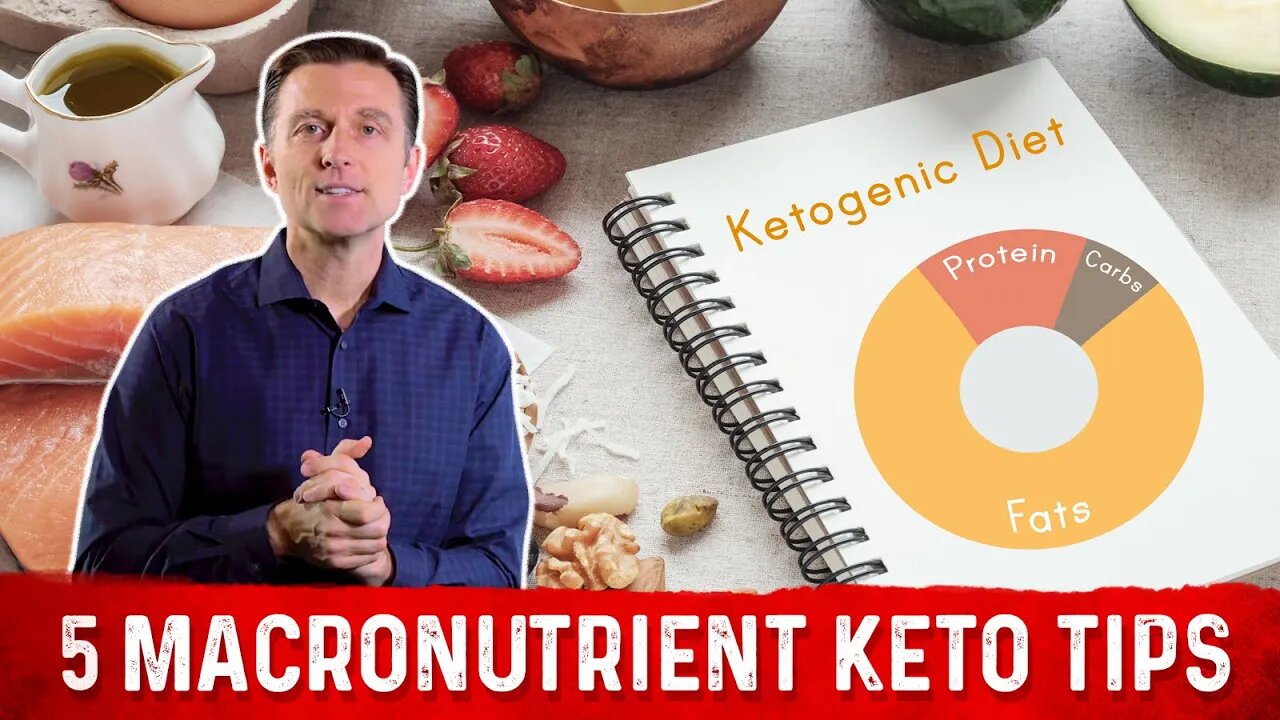Premium Only Content

Top 5 Keto Macros (Micronutrients) Tips – Dr. Berg
In this video, I’ll give you five tips for consuming the correct amount of keto macros, so you can avoid common mistakes that people make while on a keto and intermittent fasting program.
Timestamps
0:00 Five tips for consuming keto macros, so you can avoid these common mistakes
0:37 Each of the three macros should make up a percentage of your total calories
1:32 My five tips start with this: don’t consume your protein first
2:52 About seventy percent of your calories should come from fats, although this can range
4:09 Watch out for hidden carbs, especially when you’re eating at a restaurant
You’ve probably seen a pie chart for keto that says to eat a certain percentage of the three macronutrients for keto: protein, carbs, and fat. These percentages refer to a portion of your total calories. They aren’t grams of macros.
If you’re doing keto and still eating three meals per day because you haven’t yet started intermittent fasting, I recommend five percent carbs, five percent vegetables, twenty percent protein, and seventy percent fat.
If you’re eating two meals or one meal, the percentage of your carbs will go up. But as long as you keep the number of grams of carbs to between twenty and fifty per day, you’ll be fine. Don’t worry about the percentage.
Because vegetables have a lot of mass, seven to ten cups per day comes out to about five percent of your total calories, whether you’re eating one, two, or three meals each day.
My first tip: don’t consume your protein first. It’s easy to overeat, resulting in an insulin spike. But if you don’t consume enough, your liver breaks down your muscles to create glycogen (sugar) for fuel.
Second tip: consume your vegetables first. Eat ten cups daily if you’re consuming three meals per day; eight cups if two meals a day; seven cups if one meal per day.
Third tip: adjust the fats based on how you feel after you eat them. If you feel over-full and bloated, reduce the amount. If you feel hungry soon after a meal, increase the amount.
Fourth tip: keep your net carb intake between twenty and fifty grams per day. Net carbs are total grams minus the fiber in a given food. If you have a slow metabolism, aim for twenty; if it’s faster, you can go up to fifty. Beware of hidden carbs, especially in restaurant foods.
Fifth tip: consume quality protein; for example, wild-caught or grass-fed. Use organic vegetables and high-quality fats like avocados and coconut oil. My five tips for making sure you’re eating the right amount of keto macros.
Talk to a Product Advisor to find the best product for you!
Call 1-540-299-1556 with your questions about Dr. Berg's products. Product Advisors are available Monday through Friday 8am-6pm and Saturday 9am-5pm EST.
* At this time, we no longer offer Keto Consulting and our Product Advisors will only be advising on which product is best for you and advise on how to take them.
Dr. Eric Berg DC Bio:
Dr. Berg, age 56, is a chiropractor who specializes in Healthy Ketosis & Intermittent Fasting. He is the author of the best-selling book The Healthy Keto Plan, and is the Director of Dr. Berg Nutritionals. He no longer practices, but focuses on health education through social media.
Follow Me On Social Media:
Facebook: https://bit.ly/FB-DrBerg
Instagram: https://bit.ly/IG-DrBerg
Anchor: https://bit.ly/Anchor-DrBerg
TikTok: https://bit.ly/TikTok-DrBerg
DR. BERG'S SHOP: http://shop.drberg.com/
Send a Message to his team: https://m.me/DrEricBerg
ABOUT DR. BERG: https://www.drberg.com/dr-eric-berg/bio
Disclaimer:
Dr. Eric Berg received his Doctor of Chiropractic degree from Palmer College of Chiropractic in 1988. His use of “doctor” or “Dr.” in relation to himself solely refers to that degree. Dr. Berg is a licensed chiropractor in Virginia, California, and Louisiana, but he no longer practices chiropractic in any state and does not see patients so he can focus on educating people as a full time activity, yet he maintains an active license. This video is for general informational purposes only. It should not be used to self-diagnose and it is not a substitute for a medical exam, cure, treatment, diagnosis, and prescription or recommendation. It does not create a doctor-patient relationship between Dr. Berg and you. You should not make any change in your health regimen or diet before first consulting a physician and obtaining a medical exam, diagnosis, and recommendation. Always seek the advice of a physician or other qualified health provider with any questions you may have regarding a medical condition.
Thanks for watching!
I hope you find my five tips for consuming keto macros helpful.
-
 6:29
6:29
Dr. Eric Berg
15 days agoSTOP Eating for 3 Days
8.26K16 -

SpartakusLIVE
7 hours ago#1 Monday MOTIVATOR || Charity Stream Wednesday, The Gauntlet SOON, and 2v2s RETURN?!?!
45.6K -
 2:58:23
2:58:23
TimcastIRL
6 hours agoBiden Pardons WERE FAKE, NYT Report PROVES Trump WAS RIGHT, Fauci Faces Charges | Timcast IRL
250K87 -
 8:01
8:01
MattMorseTV
11 hours ago $5.66 earnedTrump just DROPPED a BOMBSHELL.
42.8K51 -
 LIVE
LIVE
Cancel This Podcast
6 hours ago $0.57 earnedROLE-PLAYING GRINDS: FINAL FANTASY XIV, DRAGON QUEST X & OCTOPATH COTC - CTP GAMING MONDAYS!
309 watching -
 7:25:37
7:25:37
FoeDubb
7 hours ago🏰KINGDOM MENU :🎮LATE NITE PUBG 🤣MOST LIKELY A BAD IDEA DILLY DILLY!!!
11.2K -
 1:34:52
1:34:52
Glenn Greenwald
9 hours agoIs There Evidence of Epstein's Ties to Israel? Yes: Ample. Brazil's Chief Censor Orders Rumble to Ban US Citizen and Turn Over Data | SYSTEM UPDATE #486
151K130 -
 2:20:40
2:20:40
GamerGril
3 hours agoMarvel Rivals Monday | Battle Of The Bronze
10.6K3 -
 46:08
46:08
FanatikGaming
2 hours ago $0.71 earned💪Monday Motivation🦾 - Legends Never DIE!💯💯 ATWU - BTTB!☝️🔥
14.8K2 -
 LIVE
LIVE
WolfLinksShadow
3 hours agoMario Kart Monday & More!
193 watching